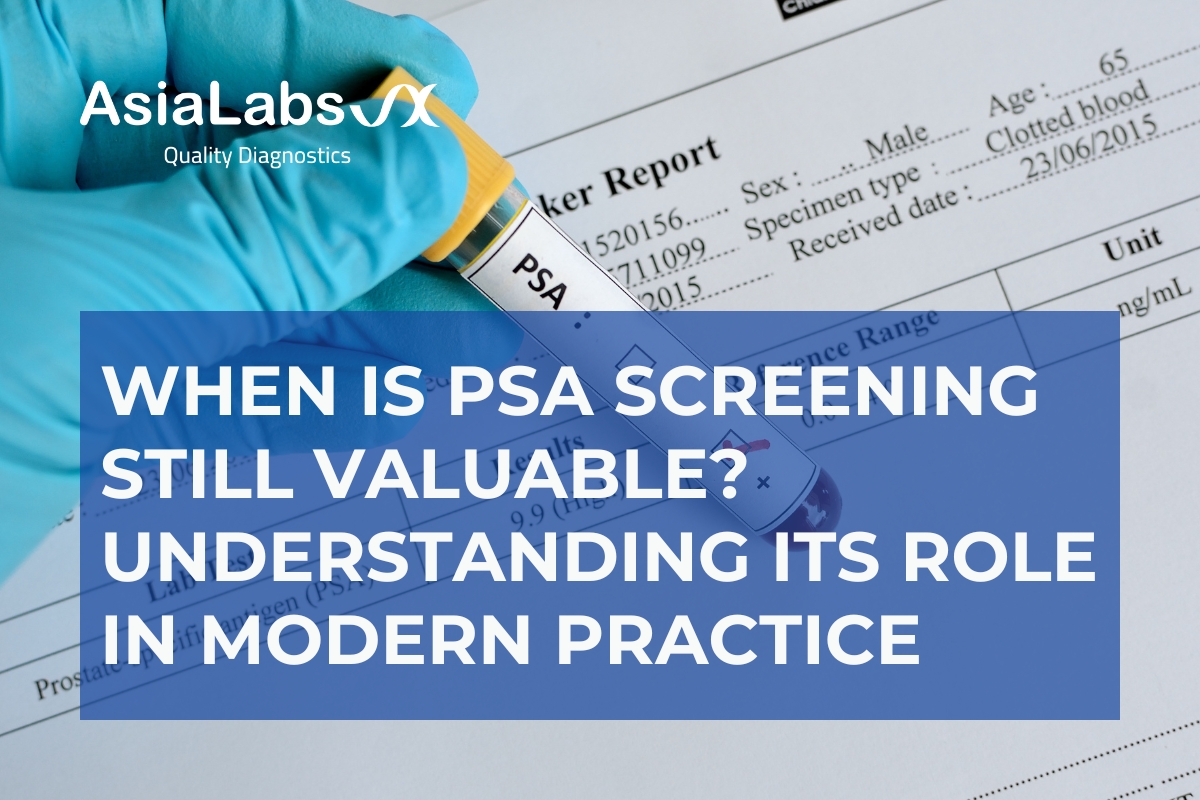Prostate-specific antigen (PSA) testing has long been a mainstay in the early detection of prostate cancer. Over the years, however, its value has been hotly debated. Critics have raised concerns about overdiagnosis, unnecessary biopsies, and overtreatment. Yet, when used thoughtfully and in the right clinical context, PSA screening remains a powerful, life-saving tool—especially for those at increased risk.
At AsiaLabs, we believe that the key to effective PSA screening lies in following evidence-based guidelines, applying nuanced interpretation, and leveraging advanced analytics to provide clinicians and patients with clear, actionable data. Here’s how PSA testing continues to play an essential role in modern urology, and how AsiaLabs helps you use it wisely.
The Evolution of PSA Screening: From Controversy to Clarity
PSA is a protein produced by both normal and malignant cells of the prostate gland. Elevated PSA levels can indicate prostate cancer, but also benign conditions like prostatitis or benign prostatic hyperplasia (BPH). In the past, widespread PSA screening led to a surge in prostate cancer diagnoses, many of which were low-risk and unlikely to cause harm. This prompted concerns about overdiagnosis and unnecessary treatment.
However, newer studies and updated guidelines have clarified when and how PSA screening is most beneficial. When targeted to the right populations and interpreted in context, PSA testing can significantly reduce the risk of advanced, metastatic prostate cancer and save lives.
Who Should Be Screened? Following the Guidelines
AsiaLabs adheres to the latest recommendations from the European Association of Urology (EAU) and the American Urological Association (AUA):
-
Average-Risk Men: Baseline PSA screening is recommended between ages 45 and 50. This provides a reference point for future monitoring and helps identify men at increased risk.
-
High-Risk Groups: Men of African descent and those with a family history of prostate cancer should consider starting screening earlier, as they face a higher lifetime risk.
-
Interpretation of Elevated PSA: A PSA level above 4.0 ng/mL, or a rapidly rising PSA, warrants further investigation, but must be interpreted with caution and in the context of age, prostate volume, and other risk factors.
Beyond the Number: Advanced PSA Analytics at AsiaLabs
PSA is not a perfect test, but its specificity and predictive value can be significantly improved with additional analyses. AsiaLabs offers a comprehensive, data-driven approach to PSA screening:
1. Free PSA Ratio (%)
When total PSA falls in the “grey zone” (4–10 ng/mL), distinguishing between benign and malignant causes becomes challenging. The free PSA ratio—the percentage of PSA circulating unbound in the blood—can help. Lower free PSA percentages are associated with a higher risk of prostate cancer, while higher ratios suggest benign conditions. Studies show that using free PSA improves cancer detection by about 20% in borderline cases, reducing unnecessary biopsies.
2. PSA Velocity
Tracking how PSA changes over time (PSA velocity) is crucial. A rapidly rising PSA, even within the normal range, can be a red flag for aggressive disease. AsiaLabs provides trend reporting, allowing clinicians to see PSA changes across multiple visits and make more informed decisions.
3. Age-Adjusted Thresholds and Digital Flags
PSA levels naturally increase with age. AsiaLabs incorporates age-adjusted reference ranges and digital flags in our reports, helping clinicians interpret results in the context of each patient’s age and risk profile.
Why PSA Screening Still Matters
Despite its imperfections, PSA screening has a proven impact on patient outcomes:
-
Reduces Advanced Cancer: Large studies show that organized PSA screening reduces the incidence of metastatic prostate cancer by approximately 30%. Early detection means more treatment options and better survival rates.
-
Informs Shared Decision-Making: With nuanced interpretation and advanced analytics, PSA screening can help patients and clinicians make informed, personalized decisions—balancing the benefits of early detection with the risks of overdiagnosis.
-
Guides Further Testing: Free PSA and PSA velocity help clarify ambiguous cases, ensuring that biopsies and interventions are reserved for those who truly need them.
Making PSA Screening Work for Your Patients
The key to effective PSA screening is not to apply a one-size-fits-all approach, but to tailor testing and interpretation to each patient’s unique risk factors and clinical context. Here’s how AsiaLabs supports you in this process:
-
Evidence-Based Testing: We follow the latest guidelines to ensure that screening is appropriate and targeted.
-
Contextual Reporting: Our lab reports include interpretation notes, trend analysis, and age-adjusted thresholds, making it easier for you to explain results to patients.
-
Patient Education: We provide resources to help patients understand the meaning of their PSA results, the pros and cons of screening, and the next steps if further evaluation is needed.
Conclusion: Informed, Context-Driven PSA Screening
PSA screening is not obsolete—it’s evolving. When used judiciously and interpreted in context, it remains a valuable tool for detecting prostate cancer early and reducing the risk of advanced disease. AsiaLabs is committed to supporting clinicians with accurate, timely, and nuanced PSA testing, so you can help your patients make informed, evidence-based decisions—not fear-based ones.
With AsiaLabs, PSA screening is not a shot in the dark. It’s a data-driven, patient-centered process that puts clinical judgment and patient well-being at the forefront.

